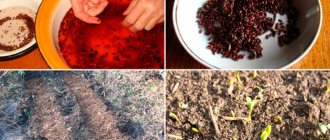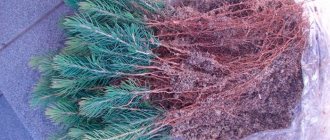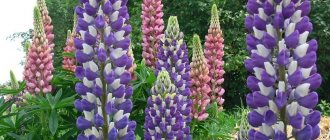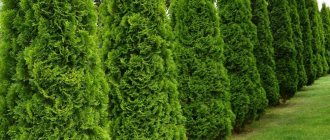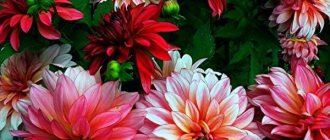Blue spruce is considered a rare plant. It is listed in the Red Book, and the cost of its seedlings exceeds the average market price. The tree is quite whimsical and requires attention. Moreover, from a whole bed of seedlings, only 30% of the total number of plants can turn into a full-fledged tree. The remaining trees will have the usual color of the needles.
We'll look at how to grow blue spruce from seeds at home below. There is no guarantee that you will be able to do all the work, but if you don’t try, you won’t have a chance. All work on growing spruce can be divided into several stages; we will consider each of them in detail.
Collection and preparation of seeds
Blue spruce seeds are found in cones, which are collected in late fall. If the cones are wet, they need to be dried for 2-3 days. Otherwise, the seeds will not fall out of the cones. After drying, the cones will fluff up. You need to shake each of them over a blank sheet of paper.
Important! It is better to carry out the procedure for extracting seeds from cones with rubber gloves, since the cones secrete resin, and it sticks and is difficult to wash off the skin of the hands.
Conditions for growth
An important step in growing blue spruce from seeds is stratification. This is the process of treating plant seeds with prolonged cold. The seeds are kept at temperatures from 0°C to +5°C for about three months in moist soil. In fact, this process lasts from the beginning of December to the end of February. After the container with seeds is kept in a room at room temperature. Blue spruce seedlings are susceptible to diseases, like any other seedlings. To prevent the death of seedlings, it is necessary to place them in a well-lit place, moisten the soil moderately and maintain the temperature at approximately 20°C.
Features of soil for spruce
Blue spruce prefers to grow in slightly acidic soil. The ideal choice of the desired substrate for it is soil from a coniferous forest, on the territory of which nature itself has regulated the required level of acidity and the population of beneficial mushrooms. From such soil the plant absorbs nutrients better.
Important! Blue spruce can grow up to 15 m in height, and in diameter
-
up to 8 m. Take these parameters into account when planting these plants in your summer cottages.
You can also use various mixtures for growing:
- The coconut substrate is mixed in equal parts with sifted peat. This mixture has good hygroscopicity, water and breathability. You can add fertilizer - 20 g of ammophosphate per 1 bucket of soil mixture.
- Ready-made, “purchased” soil for seedlings is mixed in equal parts with sand.
Some gardeners advise planting exclusively in sand. But the germination rate of seedlings in a mixture of sand and soil is much higher than in pure sand.
Where to plant a spruce in a summer cottage
The choice of location on the site is related to the size of the mature tree, so this issue must also be resolved with the neighbors. In addition to dwarf varieties, spruce trees can be a nuisance. They are planted away from houses and buildings (“real” spruce trees, growing up to 20 meters or more, are better not planted in dachas). Spruce grows almost anywhere, but becomes most lush in good sunlight. However, direct rays at midday are undesirable, so a place in partial shade is usually chosen.
The optimal soil is light, loose loam. Close proximity to groundwater and lowlands with stagnant melt water are contraindicated. It is worth remembering that spruce “deprives” its neighbors of moisture and nutrients: in the immediate vicinity of it, not only vegetable crops, but even fruit trees grow poorly.
Step-by-step instructions for growing in a pot
It is better to plant seeds in separate containers . This will avoid injury to the plant’s root system during transplantation. The bottom third of a plastic bottle can be used as containers. It is also recommended to purchase a plastic cassette with cells for planting seeds or, even better, a foam cassette. The larger the cell volume, the better. The more time the plant vegetates in the cassette, the greater the likelihood that it will survive.
Did you know? When growing blue spruce from seeds, only 30% of the seedlings will be blue. When cuttings, the similarity of the young plant with the mother plant is 100%.
Let's consider step by step how you can grow trees from seeds.
- Holes are made in the bottom of the pot. They should be placed on the side 1.5 cm above the lowest point. This is necessary to ensure that the soil is constantly moistened, even when the watering dates are accidentally missed.
- Drainage is placed at the bottom. The plant does not tolerate stagnation of water. To do this, you can use broken brick, crushed stone, expanded clay, etc. Such a loose layer will prevent the process of rotting of the root system.
- Pour the soil mixture into the pots.
- In each container, closer to the center, at a distance of 2 cm from each other, one seed is placed in holes 1–1.5 cm deep (approximately 7-8 pieces in a PET bottle container). Each cell in the cassette contains 1 seed.
- The holes are covered with a layer of soil and moistened with warm water using a spray bottle. There is no need to plant the seeds deeply, otherwise they will take a long time to germinate. Watering should not be abundant, otherwise the seedlings will die. If several sprouts sprout at the same time, it is necessary to leave the strongest one and remove the rest.
- The next stage of cultivation is stratification. You can keep containers with sown seeds in the cellar or in the refrigerator, after placing them in plastic bags. Periodically, containers must be taken out, ventilated and moistened the soil.
- After some time, the containers are moved indoors and kept at room temperature. Two weeks later, the first shoots appear.
Video: How to grow a blue spruce from a cone
To germinate blue spruce seeds, use the cotton pad method. For this:
- The cotton pad is placed on a plastic cover for support, having previously been soaked with water.
- Place seeds on it (approximately 15 pieces per disk) and cover the top with a second moistened cotton pad. All blanks are placed in a plastic bag.
- Sowing is done in early spring, kept on the balcony or in the refrigerator for 1.5–2 months, and then placed on the windowsill, periodically moistening the cotton layers.
- After the seeds germinate, each sprout is planted in separate pots.
Selecting a location
In order for the seedlings to be good, the first step is to choose the right place. It is better to choose one with good lighting. An adult tree is unpretentious and can grow on any type of soil. In addition, they do not require a lot of moisture. For the first six months, the plants are kept in a greenhouse. You can plant the seedling first indoors in a special container.
Then the seeds are prepared. First, they are strengthened by placing them under the snow for a while. They should stay there for about two months. This procedure can be replaced by another - soak the seeds for a day in a 1% solution of potassium permanganate. To do this, take 10 g of potassium permanganate per 1 liter of water. If everything was done correctly, the first shoots will not take long to appear and will appear in about 2 weeks.
Care during emergence
After the emergence of seedlings, they need to be thinned out. The distance between plants should be at least 6 cm. Only full-sized plants should be left. Watering is carried out by spraying. The soil must be constantly moist. Drying out and overflowing are not allowed. The temperature is maintained constant: from 13°C to 15°C. Containers made from plastic bottles must be covered with lids - closed containers better retain moisture and temperature and create a microclimate that promotes growth.
We recommend that you learn about the best varieties of spruce trees for landscape design.
Transplantation into open ground
Plants are transplanted into open ground in early spring in the second year after seed germination, before they begin intensive growth . The soil in the pots is watered abundantly so that the sprouts can be easily removed from the container along with the soil. The root system of plants is very delicate, so it needs to be damaged as little as possible and not overdry.
Before planting, the roots of the seedlings can be treated with a clay mash and planted in a checkerboard pattern (15x25 cm), adding soil from a coniferous forest to the planting holes. In the third year, young trees are transplanted at a distance of 1x1 m from each other. If after three years you have 50% of the seedlings left, this is a good result.
Business registration
To register a business, you need to submit documents to the tax service and register as an agricultural producer. For the organizational and legal form of commercial activity, you can choose individual entrepreneur or LLC . You will also need to submit documents to the Pension Fund and the Social Insurance Fund to open a current account. No special permits or licenses are required.
Paperwork
To register as an individual entrepreneur, you will need the following package of documents:
- application for registration;
- passport;
- TIN;
- receipt of payment of state duty.
To register an LLC, a more significant package of documents is required. You will need the company's charter and minutes of the founders' meeting. The state duty for a limited liability company is 4,000 rubles.
Aftercare
After the transplant, for two weeks, you need to take care of careful proper care:
- soil moisture must be constant;
- temperature regime of growth - within 13–15°C;
- seedlings must be shaded from the sun.
Did you know? The needles on spruce trees change gradually. Each needle takes about 7 years to grow.
Further care in the open ground differs little from the care of other garden trees. Young Christmas trees need weeding and loosening of the soil. Fertilizers are applied once every 4 years. Trees do well at a distance of at least 2 m from each other. The tree trunk circle must be covered with a layer of mulch. To do this, use a mixture of compost, peat and sawdust. The thickness of the mulch layer is 7-8 cm. The strengthened tree is trimmed to maintain a symmetrical shape. Young shoots that violate the required proportions are pruned. During the dry season, trees are watered, otherwise they will stop growing.
Tips and tricks
When growing blue spruce trees you need to know that:
- Coniferous plants do not tolerate transplantation well, so it is better to cut the container in which the Christmas tree is growing and plant the plant with a ball of earth in open ground.
- Blue spruce should not be over-fertilized. Otherwise, fertilizing will provoke excessive growth of the tree, and its wood will not have time to ripen by winter. When exposed to frost, the tree may die.
- There is no need to rush to throw away planted seedlings if you do not like the color of their needles. Only in the second year of life will they acquire their unusual color.
- It is not practical to plant blue spruce plants in the garden after corn, tomatoes or potatoes. Young seedlings grow poorly after such crop rotation.
- After 10–15 years, the blue spruce tree stops feeding from the main root and switches to feeding from a system of small roots. If the ground part of an adult tree has died, then the same spruce can grow from the root part.
Did you know? A coniferous tree grows in Sweden, which has been renewing its above-ground part for 9.5 thousand years.
Blue spruce is the most popular conifer tree used in landscape design. It’s up to you to grow such a beauty at home or buy it in a store. If you decide to experiment at home, then time, patience, and the above tips and recommendations should definitely lead to a positive result.
Blue spruce: briefly about the plant
Blue spruce is a slow-growing evergreen conifer native to North America. The dove tree can reach different sizes depending on its type:
- low-growing artificially bred varieties - 1-1.2 m;
- tall, reaching a height of 15 meters, there are rare specimens 30 m in height.
Blue spruce can feel comfortable in city conditions; it is not affected by dust and exhaust gases, and it has an air purifying effect. Therefore, blue spruce is often used for landscaping city parks and highways; it is planted along the roadway.
This coniferous variety is not afraid of severe frosts down to -35 degrees. Its blue color allows it to withstand extreme heat up to +50 degrees, which is unusual for coniferous plants. It is this feature that makes the tree a unique plant that can be grown in any region.
Dwarf blue spruce has a spherical or broadly conical crown. Over the course of a year, it grows 10 cm in width and the same in height. Reaches an average height of about 2 m.
Spruce Hoopsii is a medium-sized variety with bright blue needles and a height of up to 11 m.
The Iseli Fastigiata variety has a narrow conical blue crown and an unusual arrangement of branches that grow almost vertically upward. By the age of 10 it reaches 10 m in height.



